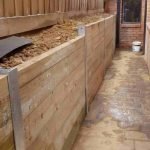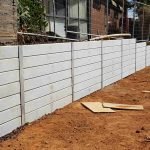Introduction
Building a keeping wall isn't practically stacking stones or putting concrete; it's a calculated undertaking that requires competence, planning, and the right materials. Retaining wall builders play a necessary role in ensuring your structure stands strong against the test of time and nature. Whether you're considering a simple wood sleeper wall or a robust concrete option, understanding the nuances of retaining walls can conserve you time, cash, and headaches down the roadway. This post will dive deep into the secrets to a lasting structure, supplying insights from retaining wall contractors and installers who know the ins and outs of this construction art.
Retaining Wall Builder: Comprehending the Basics
What is a Keeping Wall?
A maintaining wall is created to hold back soil and handle modifications in elevation. These structures are important in landscaping, specifically on sloped homes. They avoid disintegration and develop functional acreage by keeping back earth.
Why Do You Need a Keeping Wall?
If you're handling high slopes, flooding problems, or merely wish to enhance your garden's visual appeal, a retaining wall may be your best option. They can also:
- Prevent soil erosion Create level surface areas for gardening Enhance property value Improve landscape design
Types of Keeping Walls: What's Best for You?
Concrete Sleeper Walls
Concrete sleepers are pre-cast panels typically used in modern constructions. Their toughness and strength make them an ideal option for many homeowners.
Advantages of Concrete Sleepers
- Long-lasting Resistant to weather elements Minimal maintenance
Disadvantages of Concrete Sleepers
- Higher preliminary cost Requires heavy devices for installation
H Beam Retaining Walls
H beam walls utilize steel beams driven into the ground to support horizontal panels. This style is especially reliable in high-load areas.
Pros of H Beam Solutions
- Exceptional strength Suitable for high-stress applications
Cons of H Beam Solutions
- Corrosion capacity if not properly treated More complex installation process
Wood Sleeper Walls
Wood sleeper walls provide a rustic charm however need more upkeep than other options.
Pros of Wood Sleepers
- Aesthetic appeal Environmentally friendly material
Cons of Wood Sleepers
- Susceptible to rot and pests Requires regular maintenance
Timber Sleeper Walls
Similar to wood sleepers but generally made from treated wood designed for durability.

Benefits of Timber Sleepers
- Affordable choice Easy to install
Drawbacks of Lumber Sleepers
- Limited life-span compared to concrete or stone Vulnerable to severe weather condition conditions
Stone Maintaining Walls
Stone walls offer unparalleled charm and strength but can be labor-intensive.
Advantages of Stone Walls
- Timeless aesthetic Very durable when built properly
Disadvantages of Stone Walls
- High labor expenses Requires skilled craftsmanship
Choosing the Right Products for Your Wall
Factors Influencing Material Selection
Budget: How much are you willing to spend? Durability: Consider local weather condition conditions. Aesthetics: What look do you want? Functionality: Will it keep back heavy soil?Planning Your Retaining Wall Project
Step 1: Design Considerations
Visualize what you want your keeping wall to attain-- be it functional or ornamental functions. Design concepts before seeking advice from a professional retaining wall builder.
Step 2: Acquire Appropriate Permits
Regulations differ by area; ensure you have all essential permits before starting construction.
Step 3: Website Preparation
Prepare your website by clearing debris and leveling surfaces as needed. Appropriate preparation can conserve significant time during construction.
The Function of Retaining Wall Contractors
What Does a Retaining Wall Contractor Do?
An experienced professional examines site conditions, advises materials, oversees construction, and ensures compliance with regional codes.
How to Pick a Reputable Contractor?
Look for credentials. Read reviews. Ask for references. Compare quotes.Installation Process: Step-by-Step Guide
1. Digging the Trench
The first step involves digging a trench where your retaining wall will sit-- this guarantees stability.

2. Leveling Base Material
Adding gravel or crushed stone helps provide drain while keeping water far from the wall structure.
3. Laying First Course
For concrete obstructs or stone walls, this step is crucial as it sets the alignment for subsequent layers.
4. Including Drain Solutions
Incorporating drainage pipelines behind the wall avoids hydrostatic pressure buildup which might lead to failure.
5. Backfilling
Carefully backfill around the wall using proper products to minimize pressure on it while allowing for correct drainage.
Maintenance Tips for Long-lasting Maintaining Walls
Regular assessment is crucial! Here's how you can maintain your retaining walls:
Inspect annual for cracks or signs of erosion. Clean debris that might block drainage systems. Repaint or deal with wood surfaces as needed. Monitor plants growth near walls; roots can trigger structural issues.Common Mistakes in Building Keeping Walls
Neglecting drainage solutions can lead to water damage. Skipping allows leading to legal difficulties later. Inadequate foundation depth resulting in instability. Poor product options based on aesthetic appeals rather than function.FAQ Section
Q1: For how long does it require to construct a maintaining wall?
It usually takes one week or longer depending on size and complexity.
Q2: Can I construct my own retaining wall?
Yes, but it's extremely suggested that you seek advice from professionals.
Q3: How deep must my foundation be?
A foundation need to usually be at least one-third the height of your wall.
Q4: What prevents soil from pressing over my retaining wall?
Proper drain systems assist reduce hydrostatic pressure.
Q5: Can I plant greenery near my maintaining wall?
Yes! Simply ensure roots will not jeopardize structural integrity.
Q6: Is working with a professional expensive?
While expenses vary considerably, investing in knowledge settles long-lasting through quality construction.
Conclusion
Building a dependable maintaining wall isn't merely about visual appeals; it's about developing lasting structures that stand firm against natural forces while boosting residential or commercial property value and functionality. Armed with understanding about materials like concrete sleepers, wood sleepers, H beams, timber sleepers, and stone choices-- alongside insights into proper preparation and installation-- you'll have what you require to make educated choices about your project.
Whether you're thinking about DIY efforts or hiring seasoned professionals like knowledgeable retaining wall home builders or professionals, comprehending each element discussed here will pave your way toward success in building an enduring retention service that satisfies both practical requirements and aesthetic desires!